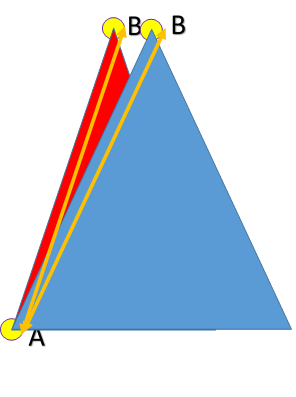Working the Angles
an·gle1
ˈaNGɡəl/
noun
noun: angle; plural noun: angles
- 1. the space (usually measured in degrees) between two intersecting lines or surfaces at or close to the point where they meet.
- 2. a particular way of approaching or considering an issue or problem.
I love both definitions, as they are both so relevant to the barrel pattern in different ways. If you are a barrel racer, you need to educate yourself with both definitions and use them to your advantage.
What to consider or approach differently when the Angles change:
What? What angle changes? When does an angle change in barrel racing? There are 2 major angle variances in barrel racing and they are often overlooked, unplanned or “unconsidered” if you will, when choosing your pattern path in barrel racing.
The Angle to the first barrel and the angle from 2nd to 3rd can change drastically from pattern to pattern. How does this change you ask? Well, if it isn’t a standard pattern, odds are, you are working with different angles.
Producers often try to optimize arena space when choosing their pattern. They try to keep standard measurements off the wall or fence, but don’t often consider how they are changing the angles of the pattern. If you aren’t aware and proactive on the angle change, this could certainly cost you a tipped barrel.
Here are the angles on a standard pattern. 105’ between 2nd & 3rd, and 90’ between 1st & 2nd. You can see the angle inside the triangle at 2nd barrel is 64.62 degrees. What happens when we modify these numbers and change the pattern?

This is an example of a small indoor pattern. These patterns are often seen in the northern states and Canada, as we often run in building with arenas that are 85’ x 200’.
We now have a much steeper angle to get up to the 3rd barrel. Our angle has changed to 71.12 degrees.
The shortest distance between 2 points is certainly a straight line or path, so how and where must we adjust our path to accommodate these changes in angles?
“You can’t connect the dots looking forward; you can only connect them looking backwards.” Steve Jobs
Sometimes the best way to approach a problem is to work it backwards. This is relative in many complex mathematical equations and it applies on finding your angles and approach to barrels on different size patterns as well.
When I lay the triangles over top of each other and line up the point on the center of second barrel, it really highlights how much steeper the angle to third can be based on pattern dimensions. These are scale drawing so the angle is very accurate. The orange line represents your perfect path to the third barrel on both patterns. Straight as an arrow from your departure point (point A) to your arrival point (point B). If you are used to small patterns and venture out on a big pattern and finish the 2nd barrel turn with the same angle to 3rd barrel you always do, you are going to over finish the turn and end up on the wrong side of the 3rd barrel and will need to make a huge correction to get yourself moved over to the correct side of the barrel. If you are used to a standard pattern and finish the 2nd barrel turn with the same angle to 3rd you always do, you are going to end up in no mans land and have to get back closer to the barrel. Either way this costs time on the clock two-fold. Firstly, anytime you make a line correction you are adding length to the line. Secondly, making lateral adjustments to a line costs the momentum.
If you are used to small patterns and venture out on a big pattern and finish the 2nd barrel turn with the same angle to 3rd barrel you always do, you are going to over finish the turn and end up on the wrong side of the 3rd barrel and will need to make a huge correction to get yourself moved over to the correct side of the barrel. If you are used to a standard pattern and finish the 2nd barrel turn with the same angle to 3rd you always do, you are going to end up in no mans land and have to get back closer to the barrel. Either way this costs time on the clock two-fold. Firstly, anytime you make a line correction you are adding length to the line. Secondly, making lateral adjustments to a line costs the momentum.
The easiest way to get your angle to the third barrel and your straight line is to work the line backwards. Start at point B facing the 2nd Barrel. Walk to the second barrel where you are going to finish your 2nd barrel turn (Point A). Make a conscious effort to keep your line straight and walk engaged and purposefully from point B to point A. I recommend putting a physical object at point A and point B (something so simple as a pop can work, cones are great too!) so you really have something to focus on. When you have completed this task, walk into no mans land and really assess your line. Is it straight? If it is not, you may need another physical barrier to help straighten out your line. Putting 2 ropes down quite narrow (1 1/2 feet apart) and walking down the center of them is a great way to make yourself stay straight. Just like all aids we use, make sure to use it as an aid. Practice, take the aid away and test yourself out. Aids can quickly becoming crutches when not used in moderation. If your line is straight, great. Now do the pattern the correct way, following the straight line path you made. Play with different patterns and angles often so you don’t get on auto pilot and are making the correct line for the pattern you are racing on, versus what you have practiced a million times at home.
This same concept applies to the first barrel as well. If you start at the barrel where you are going to start your 1st turn and face the alley way or gate, it is much easier to see the path you need to take.
